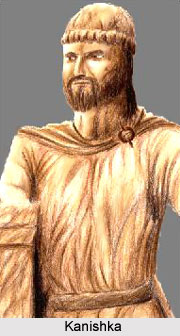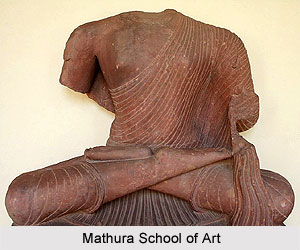The designation of Kushan art is applied to fields of paintings, sculpture and architecture from about the first to the seventh century A.D. The Gandhara School of art and the Mathura school of art are the two major institutions which flourished during the reign of the kushanas. The Kushana Empire under Kanishka proclaimed Buddhist law in Gandhara. There is a heavy influence of Buddhism on the art of this period.
 The Gandhara School of Art under the Kushanas was inspired by the Greco-roman form. The influence of Alexander`s raid in northern India has been greatly exagger¬ated, and this is particularly true of the region of Gandhara and its art. Under the Kushana emperors Gandhara en¬joyed its period of greatest prosperity and opulence, and it is to this era that the finest Gandhara sculpture is to be assigned. The art in Gandhara is in no way a continuation of the indigenous tradition. Its style is quite apart from the main stream of Indian tra¬dition, and in certain aspects almost entirely Western in form. The subject-matter is, how¬ever, Indian. The art of Gandhara is the official art of the Kushan Emperor Kanishka and his successors. The term Gandhara art is applied to this school of architecture, sculpture, and painting, which flourished in north-western India from the first to the fifth centuries A.D.
The Gandhara School of Art under the Kushanas was inspired by the Greco-roman form. The influence of Alexander`s raid in northern India has been greatly exagger¬ated, and this is particularly true of the region of Gandhara and its art. Under the Kushana emperors Gandhara en¬joyed its period of greatest prosperity and opulence, and it is to this era that the finest Gandhara sculpture is to be assigned. The art in Gandhara is in no way a continuation of the indigenous tradition. Its style is quite apart from the main stream of Indian tra¬dition, and in certain aspects almost entirely Western in form. The subject-matter is, how¬ever, Indian. The art of Gandhara is the official art of the Kushan Emperor Kanishka and his successors. The term Gandhara art is applied to this school of architecture, sculpture, and painting, which flourished in north-western India from the first to the fifth centuries A.D.
The subject matter of the Gandhara carvings is almost entirely Bud¬dhist. Although Kanishka, through his patron¬age of Buddhism, has rightly been regarded as the great patron of the Gandhara School, there is ample evidence that Hellenistic art in the form of architecture and sculpture was intro¬duced into north-western India during the reign of the Saka-Parthian Dynasties. Gandhara sculpture also began in this period and bears resemblance to roman workmanship. The Gandhara School is usually credited with the first representation of the Lord Buddha in anthro¬pomorphic form. The portrayal of Sakyamuni as a man, rather than as a symbol is linked with the emergence of devotional sects of Buddhism at the time of Kanishka"s Great Council. In addition to the origin of the Buddha image, the Gandhara School is probably to be credited with the invention of the Bodhisattva type. The Gandhara Bodhisattvas are all shown wearing turbans, jewelry, and muslin skirts, a costume that is certainly a literal adaptation of the actual dress of Kushana and Indian nobles. The jewelle¬ry of these royal statues may be duplicated in the finds of Hellenistic gold unearthed at Taxila and elsewhere. The style of these Bodhisattva images is a mixture of techniques of Western origin. The most famous Stupa in Gandhara, a veri¬table Buddhist wonder of the world, was the great tower raised by King Kanishka in Pesha¬war.
The standing and the seated Buddha are the most distinguishable Gandhara sculpture. Another important feature of Gandhara art was the Greco-Bactrians coins which equals the finest attic examples of the Indo-Greek kings. The Buddhist arts in Gandhara proper came to an end with the invasion of the Huns in northern India. The final chapters of Gandhara art have their setting, not in Gandhara, but in Kashmir where artistic activity con¬tinued at least as late as the seventh century A.D.
The Mathura school of art coin¬cides with the great century of Kushan rule under the reigns of Kanishka and his successors (144-241) A.D. and is exactly con¬temporary with the school of Gandhara. But unlike the Gandhara School of art the Mathura school is completely Indian in style and form. The city continued as an important religious and artistic centre in the Gupta Period.
The sculpture of Mathura is noted for its assimilative character and is given credit for creating the earliest Indian representations of the Buddha. A life size standing figure of Sakyamuni at Sarnath which wears the characteristic Indian dhoti is a typical example of the Mathura school of art. The sculptor is very careful to represent the distinct magic marks on the hands and the feet of the figure. Unlike the western art which sought to make an aesthetically beautiful form by portraying human figures which were models of physical perfection and athletic vigour, Mathura school of art which depicts the Indian art started with abstract spiritual concepts which had to be translated into physical shape. This distinction is evident from the heads of Buddha from the Gandhara and the Mathura school of art. The Gandhara head is a curious mixture of abstraction and realism. The brows and eyes are modeled with the hard dry-ness of carving characteristic of Late Antique art, whereas the lower part of the face is sculptured with apparent concern for the realistic definition of the structure of the mouth and chin, so that the result is at once mask-like and inconsistent. The head of the Buddha from Mathura is, on the contrary, completely con¬sistent in the sculptor`s self-imposed abstrac¬tion. The individual features are integrated into the essentially spheroid mass of the head, and no lingering over exactitude of anatomical detail interferes with the primary concern for the presentation of the solid volume of the whole.
 The Indian type of seated Buddha for example the specimen from Katra is another remarkable sculpture of the Mathura School of Art. The subtle treatment of the planes of the torso suggests a powerful feeling for the presence of the inner breath or "prana" and the countenance is characterised by a warm expression. There is an immense contribution of the Mathura school of art in the Indian Buddhist art. The sculpture of Mathura is an outgrowth of the archaic period. They depicted events from the life of Buddha and also from the Jataka tales and could be described as a shorthand manner of presentation, in which the various episodes are stripped of all details of action and setting, so that the event is often typified only by the figure of the Buddha in characteristic pose and "mudra". This exquisiteness of definition is entirely in keeping with the elegant and aristocratic conception of the figures.
The Indian type of seated Buddha for example the specimen from Katra is another remarkable sculpture of the Mathura School of Art. The subtle treatment of the planes of the torso suggests a powerful feeling for the presence of the inner breath or "prana" and the countenance is characterised by a warm expression. There is an immense contribution of the Mathura school of art in the Indian Buddhist art. The sculpture of Mathura is an outgrowth of the archaic period. They depicted events from the life of Buddha and also from the Jataka tales and could be described as a shorthand manner of presentation, in which the various episodes are stripped of all details of action and setting, so that the event is often typified only by the figure of the Buddha in characteristic pose and "mudra". This exquisiteness of definition is entirely in keeping with the elegant and aristocratic conception of the figures.
The Mathura school of art under the reign of the Kushanas marked the first really Indian development of a mature language of form dedicated to religious art. The Mathura School not only produced striking images of the Buddha but also of the gods and goddesses of the Hindu pantheon and the Jain Tirthankaras. The Mathura school of art was further improved and perfected under the Gupta period.
The Kushanas, thus, were great patrons of art. They were the pioneer in depicting Buddha in human form. The schools of Gandhara and Mathura remained the two major centers of art and sculpture during their reign and were noted for their distinctive styles.



















